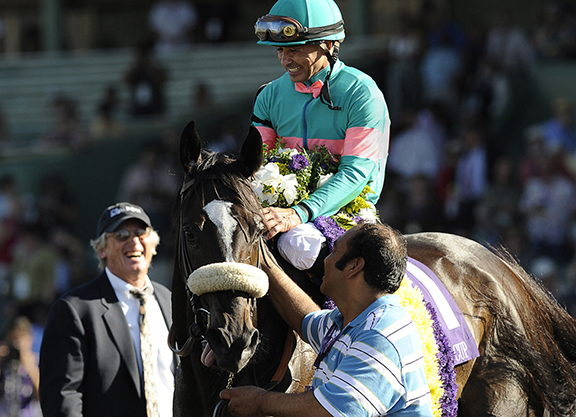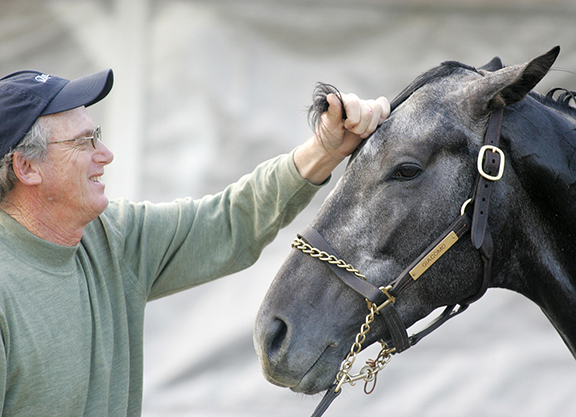In part one, Art Sherman discussed his foundational years as a horseman and trainer. Here, he talks California Chrome, managing injuries and the evolving nature of the industry.
The large, cobwebbed and straw-scattered stall brimmed floor to ceiling with a pirate's bounty of backstretch riches.
Towers of scrubbed feed buckets, a soldier's row of saddle horses stacked high with sheepskin pads and saddles worn thin at the knees, electric fans lacquered with thick dust, patched-up horse blankets chewed at the shoulders, girth sleeves tossed over doors, bridles and martingales and nosebands enough to equip a cavalry, a thick wedge of stall doors like old metal skeletons, Dali-drooped webbings draped here and there, bundles of rope and re-used feed bags and bottles of vitamins.
All Art Sherman's. All for sale. A livelihood on offer to the highest bidder.
It's fitting, then, that the Los Alamitos display case for these items–two stalls knocked into one–was once home to the horse that did more than any other to enrich a training career that is now at an end after more than four decades at the plough.
“I remember when I went back for the Preakness, a lady that breeds horses there–a big breeder in the Maryland industry–she came up to me and said, 'Art, you don't know what you've done for this business. You made people want to stay in it. It's getting to where, all of a sudden, the little guy's getting pushed out. But you came up with a horse that is the people's horse,'” Sherman said, of his two-time Horse of the Year, California Chrome.
“I'm still getting letters. I got a stack of letters the other day thanking me for all the good times. I didn't realize that many people remembered that horse that much, and from all over the world. Unbelievable.”
In spinning the offspring of an $8,000 mare and a stallion with a $2,500 stud fee into a near $15-million money maker, Sherman performed one of the most remarkable–and quite frankly, satisfying–magic acts in racing.
He didn't achieve it through sleight of hand–the smoke and mirrors of a cosseted campaign engineered to produce maximum rewards from the minimum expenditures. “He just loved to train, loved to run, that horse,” Sherman said. Indeed, California Chrome's competitive resume was busier than any other Kentucky Derby winning colt since 1991.
“He just kept getting better and better and better,” Sherman said. “I didn't expect him to blossom like he did–not into a Kentucky Derby-like horse. Not to begin with. But when I started him as a 3-year-old and he kept winning this one, and another, winning them races. Then…”
Aggressively campaigned, certainly, but judiciously handled when it came to his training, keeping the lid on very much the order of the day. “He was a natural type of horse. I tell you, he'd go a minute and change or 1:01 like–he would do anything like that so easy.”
The virtues of Sherman's less-is-more approach to the mornings can be evinced by the way he tossed tradition aside, deciding not to breeze California Chrome after arriving at Churchill Downs in the lead-up to the race.
“Because I know that track is hard and cuppy, I didn't breeze him. And a lot of the other trainers, they said, 'Well, he didn't even work, so we're not afraid of him.' No, really! Hard-boots think you have to work in :59 to be in with a shout [in the Derby]. I had a lot of apologies after that.”
Apologies would have been forthcoming, too, subsequent to the Derby of 1955, after a wet-behind-the-ears Sherman arrived at Churchill Downs with the Californian trainee, Swaps, and a few unusual tricks up his sleeve as the horse's exercise rider.
“They went crazy when we brought Swaps back there because I got on him and figure-eighted him between the barns bareback,” said Sherman, chuckling at the memory. “We'd do that all the time. I'd jump on them and figure-eight them bareback for about 15 minutes the day after working.”
Later that same year, of course, Swaps and Nashua–the horse Swaps held comfortably at bay in the Derby–met in a fabled match-race at Washington Park, a race Sherman maintains his horse should never have competed in.
“He had a hole in his frog. He had a hole in his frog like that,” Sherman said, making a gob-stopper sized circle with his thumb and fore-finger.
“They cleaned out the frog, put iodine on it, put a leather patch on it which made him go sound. But the pressure of that bad track, you know what I mean, the horse I could tell he wasn't happy on it. He was trying to get out a little bit going into his first turn. And in a match race you have to–look, speed horses always win in a match race.”
That Swaps still performed so credibly, said Sherman, was a testament to how much of a “freak” he was. “He was something else. He was a monster.”
Which leads the conversation to the current regulatory environment in California, where heightened veterinary scrutiny is bound and tied with this Gordian knot of a question: When should an issue be ignored and when should it be addressed?
On the one hand, taken as a whole, California's efforts “are better for the horses,” said Sherman. But then, the sometimes binary nature of the official veterinarian's role–either a horse is allowed to run or it's not, for instance–can mean important context that should underpin diagnostic decision-making gets lost.
“Horses can be arthritic. They're crabby. They're old. Don't just scratch him because you took him out the stall and jogged him for 20 feet and say, 'Oh, well, he looks off to me,'” Sherman said, with the frustration of someone who has spent a lifetime watching equine athletes deal with their requisite aches and pains as imaginatively as their human counterparts.
“When you ask them to run for all they've got, you're going to have horses that are going to have problems. All horses are different,” he said, turning memories from his jockey days. “I've never had a crippled horse fall with me. It's the sound ones I always got hurt on, and that's no lie. Sound ones, they don't protect themselves.”
And so, the question evolves into even more of an intangible: How do you manage horses with different pain thresholds?
“I was riding a horse once–brave horse. Bad knees. He had a knee that you could put your foot on, looked like a step stool,” he said. “After he raced, he laid down for three days. Couldn't get up. They would never let you run these horses now.”
Should a horse like that be allowed to run these days?
“Oh Christ, no,” Sherman replied. Still, Sherman wonders how some of his heavy-hitters would fare if running today.
“He always had quarter cracks. He drove me crazy. Had them all the time, all four feet,” Sherman said of Lykatill Hil, his 13-time stakes winner who ran with aplomb for eight consecutive seasons.
“I never ran a horse with four bar shoes–you never hear that. That's the kind of horse he was. He was just that tough. He ran through anything. When you sent him down there and raced him, you got tied on because he was going to run,” he said.
All too often in horses, however, the spirit may be willing, but the frame is often wanting.
“He was so big and massive, when he hit the ground the vibration from the compaction of the dirt, [his hoof] started splitting into little layers.”
By keeping Lykatill Hil's feet on the softer side of hard, Sherman, once more, abjured tradition.
“We would pack him full of mud, keep him like that all day. Tried to keep his foot soft and not brittle, like he could get. His feet just dried out so bad. It was a challenge.”
“I kept him running for a long time,” Sherman added, proudly.
Talk of the longevity–or not–of the average racing career among modern Thoroughbreds leads to an axe that Sherman is keen to put to the round stone.
“We don't have the older horses like we used to–they were the drawing cards,” said Sherman, who knows a thing or two about the magnetic attraction of the horse.
“You can't stop and breed them horses the minute they make X amount of dollars. You've got to keep them around so we can have stars to play with, you know what I mean? You take the football players and the quarterbacks–they're draws. People come to see these people.”
Another “pet peeve”? The rise in recent decades of the numerical super trainer, which he sees as having bought to the role something of a clinical distance.
In explanation, Sherman tells the story of a friend who had a horse with an unnamed trainer on the East Coast.
“The guy went to [Belmont Park] to see his horse and he said, 'Oh, I thought my horse was here.' The trainer said, “Oh no, we shipped him to Jersey. I'll let you know how he's doing.' So, [the trainer] got on the computer. 'Oh yeah, he just galloped and he's doing really well.'”
“My friend, he shook his head when he was talking to me and he says, 'Boy, that hands-on training is no more, is it?' I said, 'No.'”
Sherman took a moment, glanced through the screen over his office door at a shedrow with more empty stalls than horses.
“I love it when I can just go and see my horses, go through and feed them some cookies and look at them and ask the groom, 'How's the temperature? How'd they eat up last night?' This is something that you see less of these days because you can't when you've got 200-300 to command. You can't do that.
“Our era is the Last of the Mohicans almost, you know what I mean? I'm getting to the point where all my friends are gone now. All the trainers I knew and was raised with and everything, that era is gone. So, I'm kind of the last of the old timers,” he said, not with a sense of nostalgia but with a hard pragmatism.
“It's a fun game. I'm going to miss it. I'm going to miss the horses.”
The post California Series: Art Sherman, Part II appeared first on TDN | Thoroughbred Daily News | Horse Racing News, Results and Video | Thoroughbred Breeding and Auctions.


